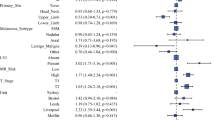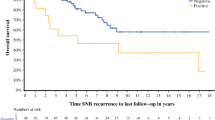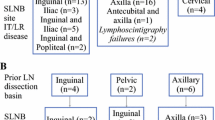Abstract
Background
The clinical significance of isolated tumor cells (ITCs) in the melanoma-draining sentinel nodes (SNs) is unclear.
Methods
Records of patients who underwent SN biopsy (SNB) for stage I/II melanoma at our institute between 1991 and 2003 were reviewed to identify patients whose SNs were tumor-free or contained only ITC (≤0.2 mm). Tumor-positive SNs were reevaluated by the study pathologist to confirm the diagnosis and microstage the SN. Characteristics of the primary melanoma, tumor status of regional lymph nodes, and other prognostic variables were recorded. Melanoma-specific survival (MSS) rates were compared by the log-rank test.
Results
Of 1382 patients who underwent SNB, 1168 (85%) had tumor-free SNs; among the 214 remaining patients with tumor-positive SNs, 57 had metastases limited to ITC. Completion lymphadenectomy (CLND) was performed in 52 of 57 patients: six (12%) had metastases in nonsentinel nodes (NSNs). At a median follow-up of 57 months, 5-year and 10-year MSS was significantly higher (P = .02) for the 1168 patients with tumor-negative SNs (94 ± 1% and 87 ± 2%, respectively) than the 57 patients with ITC-positive SNs (89 ± 4% and 80 ± 7%, respectively). Multivariate analysis identified ITC (P = .002), Breslow’s thickness (P < .0001), ulceration (P < .0001), and primary site (P = .04) as significant for MSS.
Conclusion
Patients with ITC in SNs have a significantly higher risk of melanoma-specific death than those with tumor-negative SNs. The 12% incidence of nonsentinel node metastasis is similar to rates reported for patients with more extensive SN involvement. Patients with ITC should be considered for CLND.



Similar content being viewed by others
References
Morton DL, Wen DR, Wong JH, et al. Technical details of intraoperative lymphatic mapping for early stage melanoma. Arch Surg 1992; 127(4):392–9
Giuliano AE, Kirgan DM, Guenther JM, Morton DL. Lymphatic mapping and sentinel lymphadenectomy for breast cancer. Ann Surg 1994; 220(3):391–8
Chen SL, Iddings DM, Scheri RP, Bilchik AJ. Lymphatic mapping and sentinel node analysis: current concepts and applications. CA Cancer J Clin 2006; 56(5):292–9
Morton DL, Cochran AJ, Thompson JF, et al. Sentinel node biopsy for early-stage melanoma: accuracy and morbidity in MSLT-I, an international multicenter trial. Ann Surg 2005; 242(3):302–11
Morton DL, Thompson JF, Cochran AJ, et al. Sentinel-node biopsy or nodal observation in melanoma. N Engl J Med 2006; 355(13):1307–17
McMasters KM, Reintgen DS, Ross MI, et al. Sentinel lymph node biopsy for melanoma: controversy despite widespread agreement. J Clin Oncol 2001; 19(11):2851–5
Elias N, Tanabe KK, Sober AJ, et al. Is completion lymphadenectomy after a positive sentinel lymph node biopsy for cutaneous melanoma always necessary? Arch Surg 2004; 139(4):400–4
Starz H, Balda BR, Kramer KU, et al. A micromorphometry-based concept for routine classification of sentinel lymph node metastases and its clinical relevance for patients with melanoma. Cancer 2001; 91(11):2110–21
Scolyer RA, Li LX, McCarthy SW, et al. Micromorphometric features of positive sentinel lymph nodes predict involvement of nonsentinel nodes in patients with melanoma. Am J Clin Pathol 2004; 122(4):532–9
Dewar DJ, Newell B, Green MA, et al. The microanatomic location of metastatic melanoma in sentinel lymph nodes predicts nonsentinel lymph node involvement. J Clin Oncol 2004; 22(16):3345–9
Lee JH, Essner R, Torisu-Itakura H, et al. Factors predictive of tumor-positive nonsentinel lymph nodes after tumor-positive sentinel lymph node dissection for melanoma. J Clin Oncol 2004; 22(18):3677–84
Sabel MS, Griffith K, Sondak VK, et al. Predictors of nonsentinel lymph node positivity in patients with a positive sentinel node for melanoma. J Am Coll Surg 2005; 201(1):37–47
Czerniecki BJ, Scheff AM, Callans LS, et al. Immunohistochemistry with pancytokeratins improves the sensitivity of sentinel lymph node biopsy in patients with breast carcinoma. Cancer 1999; 85(5):1098–103
van Akkooi AC, de Wilt JH, Verhoef C, et al. Clinical relevance of melanoma micrometastases (<0.1 mm) in sentinel nodes: are these nodes to be considered negative? Ann Oncol 2006; 17(10):1578–85
Govindarajan A, Ghazarian DM, McCready DR, Leong WL. Histological features of melanoma sentinel lymph node metastases associated with status of the completion lymphadenectomy and rate of subsequent relapse. Ann Surg Oncol 2007; 14(2):906–12
Morton DL, Thompson JF, Essner R, et al. Validation of the accuracy of intraoperative lymphatic mapping and sentinel lymphadenectomy for early-stage melanoma: a multicenter trial. Multicenter Selective Lymphadenectomy Trial Group. Ann Surg 1999; 230(4):453–63
Cochran AJ, Wen DR, Morton DL. Occult tumor cells in the lymph nodes of patients with pathological stage I malignant melanoma. An immunohistological study. Am J Surg Pathol 1988; 12(8):612–8
Gershenwald JE, Thompson W, Mansfield PF, et al. Multi-institutional melanoma lymphatic mapping experience: the prognostic value of sentinel lymph node status in 612 stage I or II melanoma patients. J Clin Oncol 1999; 17(3):976–83
Takeuchi H, Morton DL, Kuo C, et al. Prognostic significance of molecular upstaging of paraffin-embedded sentinel lymph nodes in melanoma patients. J Clin Oncol 2004; 22(13):2671–80
Kammula US, Ghossein R, Bhattacharya S, Coit DG. Serial follow-up and the prognostic significance of reverse transcriptase-polymerase chain reaction—staged sentinel lymph nodes from melanoma patients. J Clin Oncol 2004; 22(19):3989–96
Scoggins CR, Ross MI, Reintgen DS, et al. Prospective multi-institutional study of reverse transcriptase polymerase chain reaction for molecular staging of melanoma. J Clin Oncol 2006; 24(18):2849–57
Wong SL, Morton DL, Thompson JF, et al. Melanoma patients with positive sentinel nodes who did not undergo completion lymphadenectomy: a multi-institutional study. Ann Surg Oncol 2006; 13(6):809–16
Acknowledgments
Supported by grant CA29605 from the National Cancer Institute and by funding from the Wayne and Gladys Valley Foundation (Oakland, CA), the Harold J. McAlister Charitable Foundation (Los Angeles, CA), the Wrather Family Foundation (Los Alamos, CA), the Family of Robert Novick (Los Angeles, CA), the Samueli Foundation (Corona del Mar, CA) and the Saban Family Foundation (Los Angeles, CA).
Author information
Authors and Affiliations
Corresponding author
Rights and permissions
About this article
Cite this article
Scheri, R.P., Essner, R., Turner, R.R. et al. Isolated Tumor Cells in the Sentinel Node Affect Long-Term Prognosis of Patients with Melanoma. Ann Surg Oncol 14, 2861–2866 (2007). https://doi.org/10.1245/s10434-007-9472-y
Received:
Accepted:
Published:
Issue Date:
DOI: https://doi.org/10.1245/s10434-007-9472-y




